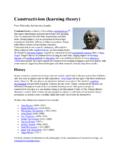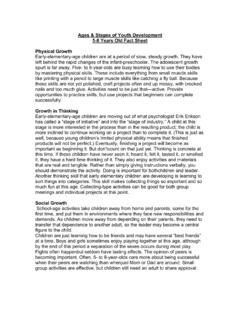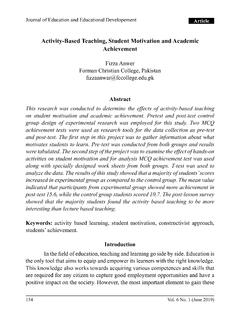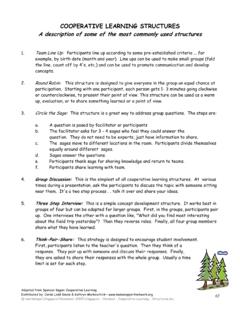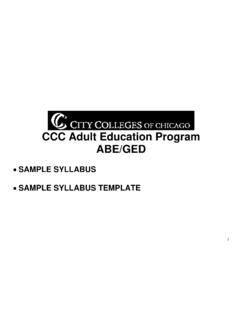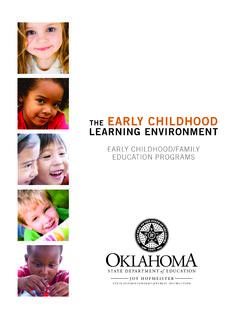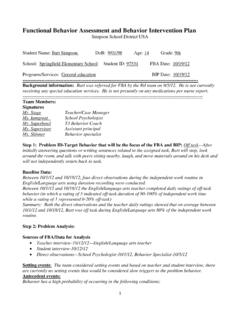Transcription of What Makes for Effective Adult Learning - Wisconsin Union
1 IntroductionTake a moment and pick the one best Learning situation in your life so far. Now reflect on that Learning situation and decide what factors made that experience great for your factors include being fully engaged in the Learning ? How about an enthusiastic and passionate teacher? A teacher who really listened to what you had to contribute? Did you mention being challenged in a safe, respectful environment? And Learning by actually doing it? Even if you didn t, as you reflect on that experience, you will most likely find that those factors were included in that Learning situation that you enjoyed so are you going to do to create a memorable Learning experience for your Mini Course participants?What follows is some information to think about as you decide how to present your Mini Course. This information is not provided as a prescription. It is offered as the best available information we could find and share to help you create a learner, and Learning , centered educational experience for your participants.
2 If you have any questions about the research, principles and techniques that follow, please ask your Program on Effective Adult EducationThere has been much research on what contributes to an Effective Learning environment for adults. Malcolm Knowles was perhaps the most famous researcher in this area. In his groundbreaking work in the 1950 s and 60 s Dr. Knowles determined that Learning in adults was most Effective when the environment included factors of: Respect Safety Immediacy Relevance EngagementIn other words adults learn best when they feel that they are being respected, their prior experience is acknowledged and respected, they feel safe in the environment, can see the immediate applicability of the Learning to something that is relevant to their lives, and engaged in the Learning process - are Learning by doing. Dr. Knowles research further showed that adults remember: 20% of what they hear.
3 40% of what they see and hear. 80% of that they do!Learners need to do something with the new information they are receiving in order to effectively integrate it into their lives and retain the information for future researchers have found that to effectively learn something we must use the whole body in the Learning . Our brain must process the new knowledge (cognitive Learning ), our heart must explore how we feel about this new Learning (affective Learning ) and our muscles must do something with the Learning (psychomotor or kinesthetic Learning ). To truly know something our Learning must involve all three domains. For example a course on investments might introduce mutual funds as a form of investment by defining a mutual fund and listing the types of funds available (cognitive piece), then table groups could share with each other their experiences, successes and fears with funds (affective segment), and finish up with a problem solving exercise (psychomotor) that requires them to apply what they have learned to the problem and move from table to table to compare strategies and others in the field of Adult education have taken this research and expanded upon it.
4 Dr. Jane Vella, drawing upon twenty-plus years of experience in teaching adults around the world, and on her work with the famous Brazilian educator Paulo Freire, has developed a set of twelve principles to guide instructors in the design and practice of their teaching. A summary of these principles is found on the next Principles for Effective Adult Teaching & Learning Needs Assessment - the participation of the learners in naming and informing what is to be learned. Safety - in the environment and the process for both the participants and the instructor. Sound Relationship - between the teacher and the learners for Learning and development. Sequence and Reinforcement - from What Makes for Effective Adult LearningA Wisconsin Union Mini Course Instructor ResourceWhat Makes for Effective Adult Learning (continued)A Wisconsin Union Mini Course Instructor Resourcesimple concepts to complex, from group supported Learning to solo efforts and reflection, then repetition of facts, skills and attitudes in diverse, engaging and interesting ways.
5 Praxis - action ( Learning ) with reflection (thought after doing). Respect - for the learner, their life experiences, AND as subjects of their own Learning . Cognitive, Affective & Psychomotor - involving ideas, feelings and actions, or the head, the heart, and the hands. Immediacy - of the Learning , seeing that is it instantly useable, using it right away. Roles - clearly defined and developed for both learner and teacher. The teacher as a facilitator of Learning , not a professor of knowledge. Teamwork - using small groups. Learners in dialog with each other, not just with the instructor. Engagement - of the learners in what they are Learning . Accountability - How does the learner know that they know?Adapted from: Learning To Listen, Learning To Teach: The Power Of Dialogue in Educating Adults, Jane Vella, 194 pages, Josey-Bass, Vella maintains that designing and offering Learning sessions that adhere to these principles will engage the learners in a dialog about the Learning .
6 If the design includes Learning by doing with time for reflection and integration into the learner s life experiences then the teacher helps insure that the learners know they know the subject at for Creating DialogCentral to Dr. Vella s principles of Effective Learning is creating dialog in your classroom. This is dialog not only between you and your participants, but also between the participants themselves. Listed below are some possible techniques that can be used to create this kind of dialog:The Warm-UpMore than an icebreaker, a warm-up is an introductory Learning task related to the topic at hand. It helps set the stage for greater Learning throughout the session. A typical warm-up might ask people to reflect on a previous experience or activity and share their thoughts with a partner. Working in pairs first creates safety and time to talk in private conversation before having to open up to the entire group.
7 The group can then be sampled for those things that they wish to Learning TaskA Learning task is an open question, or problem, put to a group or individual, with the resources needed to create an answer. Learning tasks should be properly sequenced so that they build on one another and do not assume prior knowledge. A variety of Learning tasks keeps your course fresh and can provide reinforcement of the participants to share verbally their conclusions/discussion with the large group after having worked in a small group or pair. A quick sample of two or three is usually sufficient. More can be taken (time permitting, of course) if the information is important and people are willing to ask your participants to do something that you have not done yourself. Provide an example, or model, of what you expect them to do in a Learning task. Your model should be real, and related to the actual Learning . This insures that people understand the directions and provides an opportunity to ask questions before they begin the affirm all contributions given by your class members.
8 This can be done verbally and through body language. Your learners need to know that they were heard and that what they say is valued. Acknowledging their contributions with a Thank you, a smile and nod, or by echoing back what they have said provides that affirmation. Your participants are much more likely to contribute their own thoughts and ideas if they know the Instructor values CardsUse large sized post-its (Sticky Notes On the Wall) for participants to record their discoveries or conclusions. Have them post their snow cards on a flip chart or board, saying out loud what they have written. This captures the information generated and gets people to write, and What Makes for Effective Adult Learning (continued)A Wisconsin Union Mini Course Instructor Resourcesay, what they came up with. Remember the research showed that we remember more of what we both say and do!Teamwork/Small Group WorkHave people work in pairs or small groups of three or four.
9 This creates a greater sense of safety (only having to talk to one or two other people vs. the whole class) and allows people time to think. Results of the small group work can be sampled verbally or by using snow cards. On important points/topics allow time for everyone who wants to speak, but do not require that everyone speak. Read, Circle, ShareHave participants read a short (less than one page) passage of text. Beforehand give them the direction to circle or underline those things that stand out or strike them in the passage. The group is then sampled for the things that people picked out as they read. Important points can be reinforced and learners are given a chance to share what is important to QuestionsAsking questions that cannot be answered with a simple yes or no requires greater thought and reflection by your participants. Do you have any questions? becomes What questions do you have?
10 Is everything clear? turns into What else would you like to explore about this topic? . Allow for silence when using open questions - people need time to think!Critical Incident/Case StudyProviding a scenario or short case study followed by a short series of open questions or some form of analysis offers the opportunity for strong reinforcement of previous topics and opportunity for application to the learners own life. The scenario must be close enough to be relevant yet distant enough for the audience to feel comfortable dealing with the issue(s) Question BinHang a piece of flip chart paper on the wall with the headline The Question Bin . When people ask questions that are relevant, but not exactly timely, have them write the question on a snow card and post it in the bin. Then before a break or at the end of the session take time to visit the questions in the bin. People are welcome to put questions up at any time, and reminded to take down their question should it eventually get answered in the course of the The QuestionWhen appropriate, put a question from a participant back to the audience.
